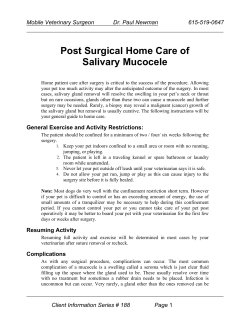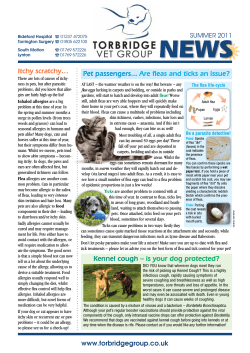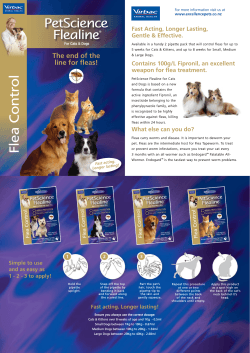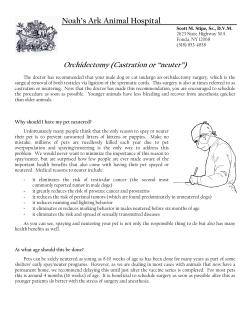
The Treatment Journey
The Treatment Journey We’ve created this Treatment Journey Guide which includes much of the information you may need to help you anticipate and manage your pet’s care and recovery throughout the treatment journey. At Western Veterinary Cancer Centre we believe the more you know, the better. This Guide is based on our many years of experience assisting the families of the dogs and cats that we treat for cancer. It will help you manage your pet’s care and recovery at every stage of the journey, with fewer unexpected twists. The key is clear communication and active participation. • Write things down: Write down questions you may have before each visit. Take notes during all discussions with the veterinary health care team about your pet's disease or treatment options. Recite information back to ensure that you understand completely. • Seek support: Bring a friend or spouse with you when you talk to the veterinary health care team. • Include the whole family: All discussions about your pet should involve everyone who loves your pet, including your children. Allow everyone to ask questions and express their opinions. • Ask for printed materials or information: Use all the resources available to help you understand your pet's disease and treatment options, including books, magazines, pamphlets and the internet. However, it is always important to ask your health care team to help you assess the reliability and accuracy of all the information you obtain. • Understand there are no incorrect decisions: You must not worry about what other people will think. You know your pet better than anyone else in the world. Once you have gathered all of the information you need, listen to your heart and you will make the right decisions. 1 Table of Contents Checklist of Questions for Your Consultation…3 About Radiation Therapy…4 About Cancer Surgery…5 About Chemotherapy…6 Side effects of Chemotherapy…8 Glossary and Toxicity Profile of Chemotherapy Drugs Used in Veterinary Oncology…10 Chemotherapy Safety at Home…13 Pain Management…14 Rehabilitation…15 Resource Links…16 Contact Information…17 Driving Directions…18 2 Checklist of Questions for Your Consultation About your pet's cancer and treatment: What is the name of my pet's tumour? Is the tumour benign or malignant? How often does this type of tumour metastasize (spread to other parts of the body)? If left untreated, what will the cancer likely do to my pet? How long will that take? If treated, what quality of life will my pet have? What is the expected survival time? What diagnostic tests do we need to perform to determine the location and extent of the cancer (i.e., the stage of the disease)? • What are all the treatment options and what are the costs, side effects, time involved, and effectiveness of each treatment? • • • • • • About your pet's pain management: • • • • • • • • • • • • • Is my pet in any discomfort? How do you assess pain in cats and dogs? How do you treat cancer pain? What role does pain management play in your cancer treatment protocols? What happens if the pain is not relieved with the usual treatment? Is severe pain considered an emergency here? Who do I call after hours? How much am I involved in choosing the specific plan for pain management in my pet? Will I receive directions in writing? Who will teach me about the plan to alleviate discomfort? Who can help when you are away? What happens if the pain does not go away? Who will show me how to give medication to my pet? About your pet's nutrition: • • • • • • • • • Is there a special diet my pet should eat? Should I give my pet special dietary supplements or extra vitamins and minerals? How much should my pet eat? What if my pet refuses to eat? When should appetite stimulants be used? What is assisted tube feeding? When would we feed my pet intravenously? Is it true that we do not want my pet to lose weight? Why? How does my pet feel when it is dehydrated? Can dehydration cause other problems? About ensuring your pet does not have an upset stomach: • • • • • • How will I know if my pet has an upset stomach? What can be done to prevent nausea and vomiting, especially relating to cancer therapy? When should I call for help if my pet is nauseated or is vomiting? Who should I call? What can be done if my pet is experiencing nausea and vomiting? What can we do to enhance appetite and to ensure a good level of nutrition? 3 About Radiation Therapy "I am very proud to have played a part in making the Cancer Centre a reality. The chance to provide truly outstanding care - at the forefront of veterinary medical science - is exciting and rewarding for professionals and their patients." – G. Neal Mauldin DVM What is Radiation Therapy? Radiation Therapy is delivered by a Linear Accelerator that generates high energy photons or electrons. Radiation is typically applied to one site to provide local therapy of a cancer. Types of Treatment: Definitive Radiation A definitive course of treatment is typically delivered in 18 to 21 fractions over 6 to 7 weeks (three fractions/week on Monday, Wednesdays and Fridays) with the total dose of radiation being 54-63 Gray. This treatment plan also typically includes a CT-based 3D radiation treatment plan. This type of treatment plan is used when there is curative intent or possibility for long term control of a cancer. Palliative Radiation A palliative course of radiation is typically 4 fractions delivered over 4 weeks (once weekly) or until desired effect is achieved. Palliative radiation can be used to slow an aggressive, nonresectable tumor’s growth, to shrink an oral tumor, or to help with pain associated with a cancer. Radiation Therapy requires precise, reproducible positioning of patients to ensure that radiation is delivered to the calculated treatment field. Normal tissue toxicity is a dose limiting factor. Therefore the amount of normal tissue in the treatment field must be minimized. To ensure proper positioning all radiation patients must be anesthetized during each fraction of their treatment protocol. At the Western Veterinary Cancer Centre each patient will have an assessment done by Dr. Matt Read prior to anesthesia to help develop the best protocol for each patient. All patients must be fasted for 10 hours prior to anesthesia. Our treatment goal is to deliver the optimal doses of radiation necessary to kill cancer cells without damaging healthy tissue. The key to doing this is our new Linear Accelerator, the first veterinary unit in Canada with Intensity-Modulated Radiation Therapy capabilities. This technology allows us to create highly complex, 3 dimensional shapes that conform to the tumour outline and to finely control and modulate the intensity of the radiation beam and deliver different doses of radiation to different areas within the treatment field. Referral of Patients: Patients for radiation therapy must have a consultation with Dr. Neal Mauldin to discuss treatment options, prognosis and overall state of health. When a treatment plan has been decided upon a CT for planning purposes will be scheduled if appropriate. Once imaging and treatment planning are complete patients are ready for treatment. Depending on the case several modalities of treatment may be warranted. Radiation Therapy will work closely with Medical Oncology and our Surgery team to achieve the best care for each patient. 4 Surgery " Many patients require multiple therapies including surgery, radiation and chemotherapy to optimize outcome and minimize treatment side effects. A coordinated, multidisciplinary approach is therefore the best way to meet the ideal needs of the patient. At Western Veterinary Cancer Centre we strongly believe that our team approach allows us to best serve each animal that we see." – Dave Szentimrey, DVM, MSc Surgery is the oldest treatment for cancer and, as a single modality, cures more animals (and people) with cancer than any other treatment. Healing from surgery is usually rapid and complete and the results in terms of cosmetics, function, and owner acceptance are excellent in most cases. Special Expertise in Surgical Oncology All board certified surgeons have advanced training, knowledge and experience regarding the surgical management of disease in dogs and cats. However, very few board certified surgeons have completed formal post-residency sub-specialist training in surgical oncology. These highly skilled specialists have a more current knowledge of tumour biology, as well as a deeper understanding of the role of surgery in the multimodality treatment of cancer, including radiation therapy and chemotherapy. They treat more cancer patients and have more extensive experience in the management of both rare and common tumours. 5 About Chemotherapy "Balancing the age and condition of the pet with the possibility of therapeutic success is never easy. But I say there's hope and reason to treat and manage even the more aggressive cancers that affect older pets. Early detection and urgent, specialized treatment are the best ways to manage neoplasia and prolong and improve a pet's quality of life." – Dr. Glenna Mauldin Chemotherapy is the use of certain drugs alone, or in combination to control tumour growth. But for many people, the word "chemotherapy" brings to mind negative associations -particularly debilitating side effects. So it’s not surprising when they shy away from treating their pets with chemotherapy. But most animals do not suffer the kinds of side effects that humans do for a variety of reasons, including: • smaller doses are given less often • animals don’t have the psychological hurdles to overcome that we do The important question to answer for any pet with cancer is “What is a realistic goal of treating this animal with chemotherapy?” In veterinary medicine, the goals we strive for are to: • control rapidly progressive disease • prevent spread of the tumour • restore deteriorated function • provide a good quality of life during the time of remission For a cancer such as lymphoma, therapy involves a significant time commitment on the part of the owner and family. For dogs, visits for chemotherapy are needed once weekly for 6 weeks, then every 2 weeks for 6 additional treatments, and finish with 4 weekly treatments. In most cats there are also 6 initial weekly treatments, after which treatments are continued every 2 weeks for a total of 12 months. We generally recommend overnight hospitalization after the first chemotherapy treatment in both cats and dogs receiving treatment for lymphoma. After this, animals are admitted as day-patients; many owners find it most convenient to drop their pet off on their way to work in the morning, and pick them up on their way home. However, we make every effort to accommodate the owner's schedule. While you have the option to halt therapy at any time, it is important to remember that it will take at least 3 to 4 weeks for some animals to enjoy the benefits of chemotherapy. All of the drugs currently given to animals are human anti-cancer drugs. Chemotherapy drugs work by targeting and damaging or killing rapidly growing cells. For the patient, this means cells lining the stomach and intestine (high turnover rate), and cells of the bone marrow that make up the immune system (white blood cells, in particular), as well as cancer cells. These medications are extremely potent, and must be carefully chosen on a case by case basis. Considerable expertise is needed to choose the most appropriate drugs, dosages and treatment protocol for each individual patient. Veterinarians that are board certified in medical oncology have specialized knowledge that is vital in making these critical decisions. Most patients complete their course of cancer therapy without major complications. Side effects tend to decrease in severity over time, as the unique drug sensitivities of each animal become better defined, as treatments are given less frequently, and once the cancer is in remission. Owners can be reassured that the most common side effects should be mild to 6 moderate and may include decreased appetite, nausea, vomiting, diarrhea, and increased risk of infection caused by bone marrow suppression. Hair loss is uncommon in cats and most dogs on chemotherapy, although certain breeds such as terriers and poodles may experience more significant hair loss. Normal cell populations, such as those in the intestine or bone marrow, can almost always regenerate themselves. This means that most chemotherapy-related complications that occur in these tissues resolve relatively quickly. At the same time, the less well organized malignant cells will suffer greater damage and have a decreased ability to repair themselves. However, even after treatment using higher doses of chemotherapy, microscopic clusters of malignant cells remain dormant but alive in the body, and will eventually give rise to drug-resistant cell lines. This is how malignant cancers recur and metastasize, and this is why many cancers that are very treatable with chemotherapy cannot necessarily be cured. 7 Side Effects of Chemotherapy Gastrointestinal Side Effects Nausea (and refusal to eat) can occur in both cats and dogs. Symptoms are usually seen 24 to 72 hours after treatment and include poor appetite, turning away from food when it is offered, and sometimes drooling. This problem is typically transient and requires no specific treatment in many cases. In other situations, anti-nausea medications are indicated and can also be administered prior to future treatments to prevent recurrent problems. Owners can try tempting their pet with highly palatable foods, as well as warming the foods slightly. Bland, relatively low fat foods such as cooked chicken or turkey breast with all fat and skin removed, or very lean boiled and drained hamburger are best. However, cats and dogs that refuse to eat after chemotherapy should not be force fed: this can result in permanent food aversions. Vomiting can also occur during chemotherapy. When it occurs within 24 to 48 hours of treatment and the pet is otherwise bright, active and does not have a fever, maropitant citrate (Cerenia?) is usually prescribed. Another effective strategy that can be used either alone or along with anti-nausea medications is to remove your pet’s food, and replace it with a pile of ice chips in a dish. As long as your pet eats the ice, this will help to maintain hydration without stimulating further vomiting. If there has been no vomiting for 12 to 24 hours, you can gradually return your pet to a bland, easily digestible diet. If your pet refuses to eat the ice, the vomiting is repetitive (more than 3 or 4 times), contains blood, or your pet seems weak, depressed or has a fever, you should seek veterinary attention. Diarrhea may occur after chemotherapy in dogs, but is often mild and transient. Diarrhea is rare in cats. Some over-the-counter human treatments may be given safely to pets and may reduce intestinal discomfort, but you should never give a human medication to your cat or dog without first consulting a veterinarian. Cats in particular are very sensitive to many human medications including aspirin and acetominophen, and can develop life-threatening complications if they are used. Kaopectate(R) may be given to dogs (not cats) at a dose of 1 to 2 cc's per kilogram body weight every 4 to 6 hours, for no more than 48 hours. Pepto-Bismol? regular strength liquid can be given to dogs (but not cats) at a dose of 1 to 2 cc's per kilogram body weight every 6 to 8 hours for no more than 48 hours. Pepto-Bismol? regular strength tablets can also be used in dogs (again, not cats) at a dose of 1/2 tablet per 10 kilograms body weight every 6 to 8 hours for no more than 48 hours. If the diarrhea is severe, persists for longer than 48 hours with or without medication, contains blood, the animal seems weak or depressed or has a fever, veterinary attention is indicated. Fever/Sepsis Virtually all chemotherapy drugs have the ability to at least temporarily suppress the immune system. This can lead to serious infections that may be life-threatening if not properly treated. Signs of Fever or Sepsis • • • • • Fever of 39.5o C or more (temperature taken by rectal thermometer should be between 37.5 and 39.5o C in both dogs and cats) Lethargy and weakness (refusal to get out of bed or reluctance to go on walks, etc.) Disinterest in food Vomiting Diarrhea 8 What if Infection is Suspected? DO NOT WAIT OVERNIGHT! Call us at WVCC immediately. This situation can be treated rapidly and almost always successfully, but appropriate antibiotic therapy is absolutely essential. An extended delay before initiation of treatment may result in health complications or even death. Your local veterinarian will also have treatment protocols for this situation and in some cases this will be more convenient for you. However, the Western Veterinary Specialist and Emergency Centre will see this type of emergency ON ANY DAY AND AT ANY TIME. 9 • Glossary and Toxicity Profile of Chemotherapy Drugs Used in Veterinary Oncology • Carboplatin (Paraplatin®) is used to treat many different cancers in dogs and cats. This drug was specifically developed as an analogue to cisplatin, and has much less gastrointestinal and renal toxicity compared to the parent drug. Carboplatin is often given in combination with doxorubicin (Adriamycin®), and is part of treatment protocols used for many carcinomas including transitional cell carcinoma of the bladder and apocrine gland adenocarcinoma of the canine anal sac. It is also commonly used to treat sarcomas, especially canine osteosarcoma. Carboplatin causes very little gastrointestinal toxicity compared to many other chemotherapy drugs, and does not cause renal injury like cisplatin. However, it can cause bone marrow suppression with low white blood cell and platelet counts. This complication is usually seen 10 to 14 days after treatment in dogs, but can be delayed to as long as 21 days in cats. • Cisplatin (Platinol®) is a platinum-containing chemotherapy drug with a wide spectrum of activity against many tumours. It can be used to treat different types of carcinoma, and it is arguably the single most effective drug for the treatment of canine osteosarcoma. However, cisplatin is challenging to administer because of its potential toxicities. It cannot be used systemically at any dose in cats, because it causes fatal pulmonary edema. In dogs, cisplatin causes severe nausea and vomiting within minutes of injection unless animals receiving it are pretreated with antinausea drugs. Cisplatin can also result in kidney damage unless it is administered along with large volumes of intravenous fluids. Dogs receiving cisplatin are admitted to the hospital the day before they are due for cisplatin treatment to receive the extra fluids they need. • Chlorambucil (Leukeran®) is used primarily to treat mast cell tumours and some types of leukemia in dogs; cats with low grade lymphoma may also receive this drug. Chlorambucil is sometimes used as a substitute drug in dogs with lymphoma that develop cystitis after receiving the chemotherapy drug cyclophosphamide. Chlorambucil is generally very well tolerated, and causes very few side effects. However, it can occasionally result in bone marrow suppression so animals that receive it must have blood work done at regular intervals to make sure that white blood cell and platelet counts remain normal. Chlorambucil is only available in an oral form, usually pills, and is often prescribed to be given daily at home. Owners that are giving chlorambucil to their pets must take care to limit their own exposure to this drug. Chlorambucil tablets should never be broken or crushed. • CCNU or lomustine (CeeNU®) is used to treat mast cell tumours in dogs. It is also used as a rescue drug to treat dogs whose lymphoma has come out of remission after their initial therapy. Although the gastrointestinal side effects of CCNU are usually quite mild, it can cause two other problems: bone marrow suppression, and liver injury. Both white blood cells and platelets can be significantly suppressed by this drug, so it is important to monitor counts very closely. Blood tests are also used to identify hepatic toxicity from CCNU. This damage is usually reversible as long as it is diagnosed early; dogs receiving this drug are also treated with S-adenosylmethionine so that hepatic complications can be minimized as much as possible. • Mechlorethamine or nitrogen mustard (Mustargen®) is part of the lymphoma rescue protocol “MOPP.” Besides Mechlorethamine, the other drugs included in this regimen are vincristine (Oncovin®), Prednisone and Procarbazine. At WVCC this protocol is our first 10 choice for dogs with lymphoma that have lost remission after initial therapy, so most dogs with lymphoma receive MOPP at some point during their course of treatment. The primary toxicity associated with mechlorethamine is bone marrow suppression and low white blood cell counts; if this problem is not quickly identified and treated with antibiotics then serious or even life-threatening infections can occur in affected dogs. Mechlorethamine also causes severe tissue inflammation, necrosis and ulceration if it is not given directly into a vein using a carefully placed intravenous catheter. • Mitoxantrone (Novantrone®) is an analogue of the commonly used chemotherapy drug doxorubicin (Adriamycin®). The toxicities associated with these two drugs are very similar, with one important exception: mitoxantrone causes significantly less cardiac toxicity when compared to doxorubicin. Doxorubicin is almost always the first choice drug, but in animals where there are concerns regarding cardiac function mitoxantrone may be substituted into the treatment protocol in its place. • Prednisone, a corticosteroid, is one of the least toxic of all commonly used chemotherapy agents. It is not actually a chemotherapy drug in the sense that it kills cancer cells, except in the case of lymphoma where it is directly toxic to malignant lymphocytes. Prednisone also has many other uses in veterinary medicine. It is well tolerated by most pets. It commonly causes increased thirst, urinations, and appetite. With long term use, it can injure the gastrointestinal lining and cause stomach ulcers and colitis. It also suppresses the immune system. • L-asparaginase (Elspar®, Kidrolase®) is an enzyme that is used to treat lymphoma and some lymphoid leukemias. At the Western Veterinary Cancer Centre, it is often given concurrently with the chemotherapy drug vincristine. The most common side effect seen with Lasparaginase is bone marrow suppression followed by low white blood cell counts that usually develop within 48 to 72 hours of administration. In rare instances, L-asparaginase can cause vomiting due to pancreatitis. Since it is a protein, there is a possibility that an animal can have an allergic reaction to it after repeated doses. Animals receiving more than one dose of this drug are always pretreated with corticosteroids and diphenhydramine (Benadryl®) to prevent problems, and they are closely monitored after their treatment. • Vincristine (Oncovin®) is also used most commonly to treat lymphoma and lymphoid leukemia. It is well tolerated compared to many other chemotherapy drugs, and causes relatively little bone marrow suppression in most animals. Some dogs will experience delayed gastrointestinal side effects with vomiting and diarrhea that generally occur 7 to 10 days after treatment. Vincristine causes severe tissue inflammation if it is not given directly into a vein using a carefully placed intravenous catheter. • Cyclophosphamide (Cytoxan®) is used primarily for the treatment of lymphoma, and occasionally in combination with other drugs to treat some types of carcinoma. It can suppress the bone marrow and cause low white blood cell counts 7 to 10 days after it is given. Animals experiencing this side effect will be weak, lethargic, stop eating, and may have vomiting and diarrhea. This complication is treatable, but immediate antibiotic therapy is needed to prevent life-threatening systemic infection. Occasionally, cyclophosphamide can cause inflammation of the bladder lining in dogs, leading to bloody urine, straining, and frequent attempts to urinate. This condition is called “cytoxan cystitis.” An intravenous diuretic is given to all dogs receiving this drug, to encourage rapid elimination of the drug from the body and decrease the likelihood of problems. In the rare cases where cystitis still 11 occurs, cyclophosphamide is removed from the treatment protocol and a different drug is used instead. • Doxorubicin (Adriamycin®) is one of the most potent and active chemotherapy agents ever developed. It is used to treat a wide variety of cancers including lymphoma, leukemia, carcinomas and sarcomas including osteosarcoma. Bone marrow suppression is more likely with this drug than some others, and low white blood cell counts requiring antibiotic therapy can be seen 7 to 10 days after treatment. Occasional animals may also experience direct gastrointestinal side effects, with nausea, poor appetite, vomiting and diarrhea that usually develops 24 to 72 hours after therapy. Effective antinausea drugs can be prescribed to treat these symptoms when they occur, and they can also be used to prevent them after future treatments. High doses of doxorubicin can cause serious cardiac side effects in dogs and people, and all dogs receiving this drug at WVCC are carefully monitored with electrocardiograms prior to every treatment to prevent this problem. Doxorubicin causes severe tissue necrosis, inflammation and ulceration if it is not given directly into a vein using a carefully placed intravenous catheter. 12 Chemotherapy Safety at Home Most chemotherapy drugs are excreted in the urine or feces within 72 hours after administration. It is recommended that you walk your pet away from his or her usual elimination spots (in a more outof-the-way spot) for those three days. You should take care to particularly avoid areas where children might play. If your pet urinates, defecates or vomits in the house during the first 72 hours after chemotherapy, you should clean up promptly wearing latex gloves, so nothing comes in direct contact with your skin. You are in no danger living with an animal that is getting chemotherapy, but it is prudent to avoid human exposure to these drugs when we can. You will be instructed to wear latex gloves, for your protection, while giving certain chemotherapy drugs at home. 13 Pain Management “My first responsibility is assuring the delivery of expert attention to each patient, ensuring that the anesthetic and pain management techniques employed at the Western Veterinary Cancer Centre are best suited to the individual's needs.” – Dr.Matt Read Everyone, from owners, to family veterinarians, to specialists and veterinary technologists must act as a team to ensure that your pet has a pain free life. It is important to try to identify when an animal is experiencing pain early when it is easiest to treat. Preemptive analgesia is beneficial to pets when perceptive caregivers and owners recognize that the situation is appropriate. Since compassion is an essential part of everything we do at Western Veterinary Cancer Centre, it follows that pain control is integral to the caring process. Recognizing When a Pet is in Pain Knowledgeable practitioners and caregivers watch for subtle changes in activity level, appetite and movements. Some pets, particularly cats, may express their discomfort audibly. Increased breathing rate, increased heart rate and dilated pupils can indicate the presence of pain, even when the animal is otherwise quiet. Some pets become more reclusive whereas others, especially younger dogs and cats, may become unusually restless and wildly active. Just as with people, every pet’s tolerance for, and response to pain is different. Recognition, evaluation and appropriate action are the basis of a pain control approach that dovetails with response to therapy and ensuing quality of life for each patient. The management of pain begins with informed, compassionate care by every member of the veterinary health care team. Sensitivity in handling and maintenance of a secure, low-stress environment is of fundamental importance. Please visit the following link for a position paper on pain management to which we at the Cancer Centre fundamentally ascribe, from the American College of Veterinary Anethesiologists. 14 Rehabilitation “Rehabilitation plays an important supportive role in the treatment of cancer.” - Dr. Veronica Devall Dr. Veronica Devall heads up our new Animal Rehabilitation program for dogs AND cats. Services offered include water therapy (underwater treadmill), low level therapeutic laser, neuromuscular stimulation, therapeutic ultrasound, therapeutic massage, acupuncture, spinal manipulative therapy (animal chiropractic), thermo-and cryo-therapies and therapeutic exercises. For dogs and cats that are receiving chemotherapy or radiation therapy, rehabilitation can decrease pain and physiological stress, improve strength and mobility, and support tissue healing. During the recovery phase, rehabilitation builds muscle strength, improves cardiovascular function and endurance, and enhances immune function. What’s “Normal” Now? One of the most important goals of cancer treatment in animals is to maintain as much of the pet’s normal lifestyle as possible. This usually means that once a pet has recovered from cancer surgery, completed their course of radiotherapy, or finished the initial phase of chemotherapy, restrictions on activities are very few. Your veterinarian will want to discuss how to help your pet regain strength and stamina. Cancer patients may be more easily fatigued with strenuous activity, so moderation is best in the beginning. However, daily walks and "playtime" are strongly encouraged, and your pet is likely to become more fit over time. You should work with your family veterinarian and the cancer care team at WVCC to design an activity program that is individually tailored to meet your pet’s needs and your lifestyle. Although weight loss is a problem in some cases, many pets with cancer will actually gain weight during therapy. Body weight is always carefully monitored throughout the course of cancer treatment and after it is completed, so that any changes are quickly identified. Obesity must be avoided because it increases the pet's risk of many concurrent diseases, suppresses immune function, and complicates accurate dosing of chemotherapy drugs. A strict weight loss regimen should never be started during intensive cancer treatment, but your family veterinarian and the cancer care team at WVCC can help you design an individualized protocol for gradual, healthy weight loss in your pet once treatment is finished. 15 Resource Links Below are links to resources that may hold additional interest and information regarding the issues you and your pet may face. The Veterinary Cancer Society http://www.vetcancersociety.org/ The American College of Veterinary Internal Medicine http://www.acvim.org/ The American College of Veterinary Surgeons http://www.acvs.org/ The Comparative Oncology Research Exchange at Cornell University http://www.vet.cornell.edu/cancer/index.html Animal Cancer Care http://www.animalcancercare.com.au/ Animal Cancer Institute http://www.animalcancerinstitute.com/index.html 16 Contact Information We welcome inquiries from all who are interested in our services. Please use the following information to contact us: Western Veterinary Cancer Centre 1802 - 10th Ave SW, Calgary, Alberta, Canada T3C 0J8 Phone: (403) 770-1340 Toll Free: 1-866-770-1340 Fax: (403) 770-1344 Email: questions@westernvet.ca 17 Driving Directions Driving Directions From North West of Calgary • • • • Head South on Crowchild Trail South Take the 12th Ave SW Exit (right lane) Continue straight on to 10th Ave SW We're at 1802 - 10th Ave SW Driving Directions North East of Calgary • • • • • Head West on Memorial Drive West Exit to Crowchild Trail South (right lane, via 25th St SW) Take the 12th Ave SW Exit (right lane) Continue straight on to 10th Ave SW We're at 1802 - 10th Ave SW Driving Directions From South West/East of Calgary • • • • • Head North on Crowchild Trail North to Memorial Drive East, then Turn Right on 14 St SW, then Turn Right on 10th Ave SW We're at 1802 - 10th Ave SW 18
© Copyright 2025









